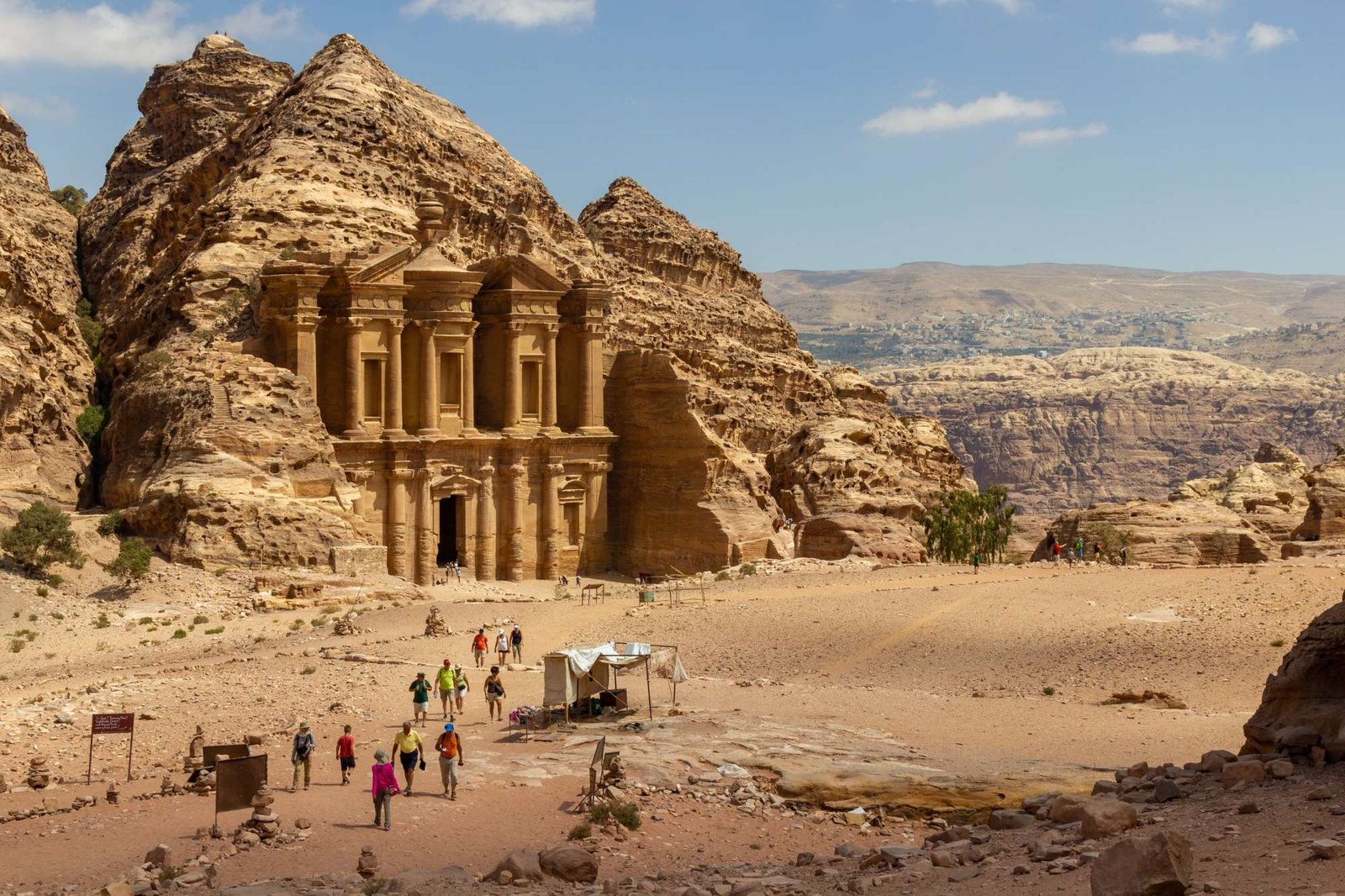Exploring Petra
Petra, an ancient city hidden within Jordan’s desert landscape. Renowned as one of the most extraordinary archaeological sites on Earth, Petra captivates visitors with its grandeur and history, carved meticulously into vibrant red rock cliffs. Petra, often referred to as the “Rose City” due to the pinkish hue of its sandstone cliffs, is an archaeological wonder located in southern Jordan. This ancient city, carved directly into vibrant red rock, is a testament to the ingenuity and artistry of the Nabataean people who established it over 2,000 years ago. Recognized as a UNESCO World Heritage Site and one of the New Seven Wonders of the World, Petra is a must-visit destination for any traveler interested in history, architecture, and culture. Here’s a brief history to enhance your visit:
 Origins and Rise
Origins and Rise
– **Early Settlement**: Petra’s origins date back to the 4th century BCE when it was established as a major trading hub by the Nabataeans, an Arab tribe that settled in the region. The city’s strategic location at the crossroads of important trade routes linking Arabia, Egypt, and the Mediterranean made it a prosperous center for commerce.
– **Nabataean Kingdom**: The Nabataeans were masterful traders, controlling the trade of luxury goods such as spices, incense, and silk. They amassed great wealth, which is reflected in the grandeur of Petra’s architecture. During its peak, between the 1st century BCE and the 1st century CE, Petra thrived as the capital of the Nabataean Kingdom.
Architectural Marvels
– **Rock-Cut Architecture**: Petra is renowned for its rock-cut architecture, where structures are carved directly into the sandstone cliffs. This includes monumental tombs, temples, and dwellings that display a blend of Hellenistic, Egyptian, and traditional Nabataean styles.
– **The Treasury (Al-Khazneh)**: Perhaps the most iconic structure in Petra, the Treasury is believed to have been constructed in the 1st century CE as a mausoleum for a Nabataean king. Its elaborate façade, featuring Corinthian columns and intricate carvings, is a masterpiece of ancient engineering.
– **The Monastery (Ad-Deir)**: Another significant monument, the Monastery, is similar in design to the Treasury but much larger. It is accessible via a challenging hike of over 800 steps but rewards visitors with spectacular views and a sense of awe at its scale and craftsmanship.
Roman Influence and Decline
– **Roman Annexation**: In 106 CE, the Roman Empire annexed the Nabataean Kingdom, and Petra became part of the Roman province of Arabia Petraea. The Romans introduced new architectural elements, including the construction of the Petra Roman Theater and colonnaded streets.
– **Decline**: Despite continued prosperity under Roman rule, Petra’s significance as a trade hub began to decline in the 4th century CE, as sea trade routes became more dominant. A series of earthquakes in the following centuries further contributed to its decline, and Petra was gradually abandoned.
Rediscovery and Modern Era
– **Rediscovery**: For centuries, Petra remained unknown to the Western world until Swiss explorer Johann Ludwig Burckhardt rediscovered it in 1812. His accounts brought Petra to the attention of scholars and adventurers, sparking widespread interest in the ancient city.
– **Tourism**: Today, Petra is one of Jordan’s most visited tourist attractions, drawing hundreds of thousands of visitors annually. Efforts to preserve its delicate structures and mitigate the impact of tourism are ongoing.
 Visiting Petra
Visiting Petra
– **The Siq**: Your journey into Petra begins with a walk through the Siq, a narrow, winding gorge flanked by towering rock walls. This dramatic entrance builds anticipation as you approach the Treasury.
– **Exploring the City**: As you explore Petra, you’ll encounter a wealth of historical sites, including the Street of Facades, the Roman Theater, the Royal Tombs, and the Great Temple. Each site offers insights into the daily life, culture, and architectural prowess of the Nabataeans.
– **Petra by Night**: For a truly magical experience, consider attending Petra by Night, where the Siq and the Treasury are illuminated by thousands of candles, accompanied by traditional Bedouin music.
A visit to Petra is more than just a sightseeing trip; it’s a journey through history. As you walk through its ancient streets and marvel at its rock-carved monuments, you’ll gain a deeper appreciation for the rich cultural heritage and architectural achievements of the Nabataeans. Whether you’re captivated by its history, architecture, or sheer beauty, Petra promises an unforgettable experience that will leave you with lasting memories.









